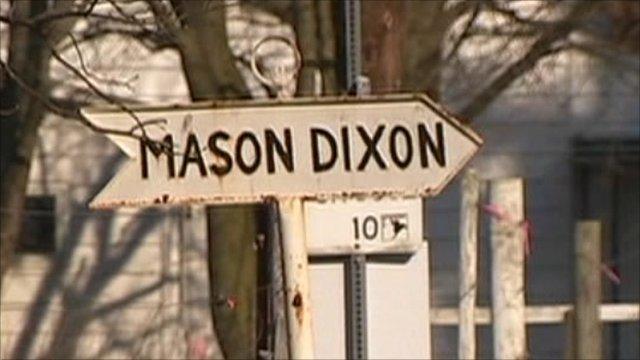The men who drew the Mason-Dixon Line
- Published
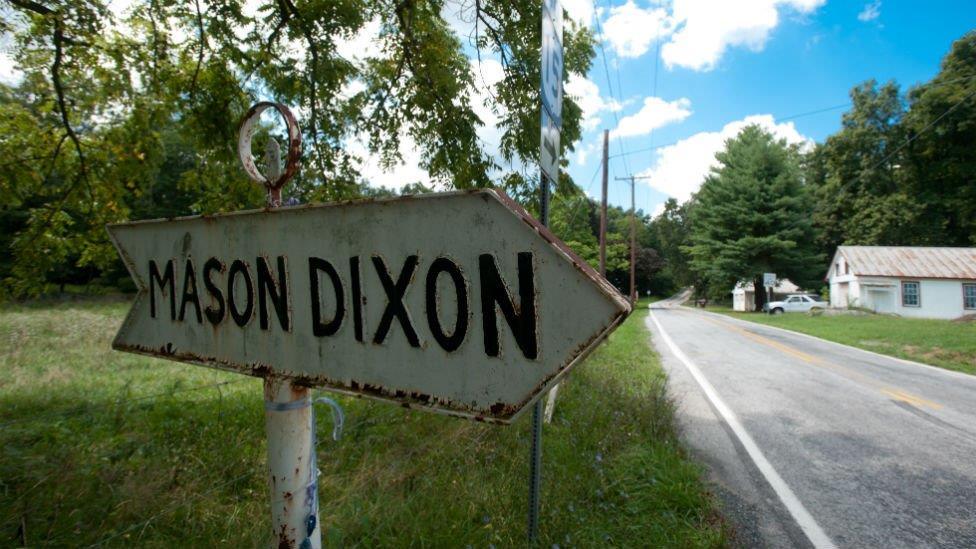
It is 250 years since America's Mason-Dixon Line was completed. Hailed as a groundbreaking technical achievement, it came to symbolise the border between the Civil War North and South, separating free Pennsylvania from slave-owning Maryland. But who were the two British men who created it?
"It was the equivalent of the moon landings today," according to Mason-Dixon Line expert David Thaler.
Baker's son Charles Mason and lapsed Quaker Jeremiah Dixon were established scientists when commissioned to settle a land dispute in the pre-revolutionary America of 1763.
For 80 years the Calvert family of Maryland and the Penns of Pennsylvania had been locked in a bloody dispute over the boundary between the two colonies they had been granted by the English Crown.
"The stakes were very high," said Mr Thaler, trustee of the Maryland Historical Society in Baltimore and an expert on the Mason-Dixon project.
"There was about 4,000 sq miles of territory that was in dispute and nobody knew who to pay taxes to. Warfare regularly broke out along the border."
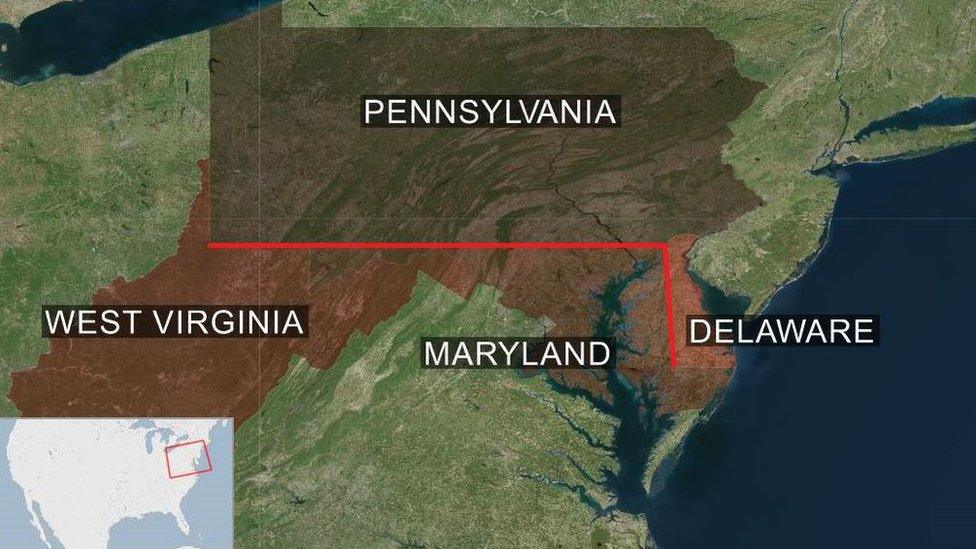
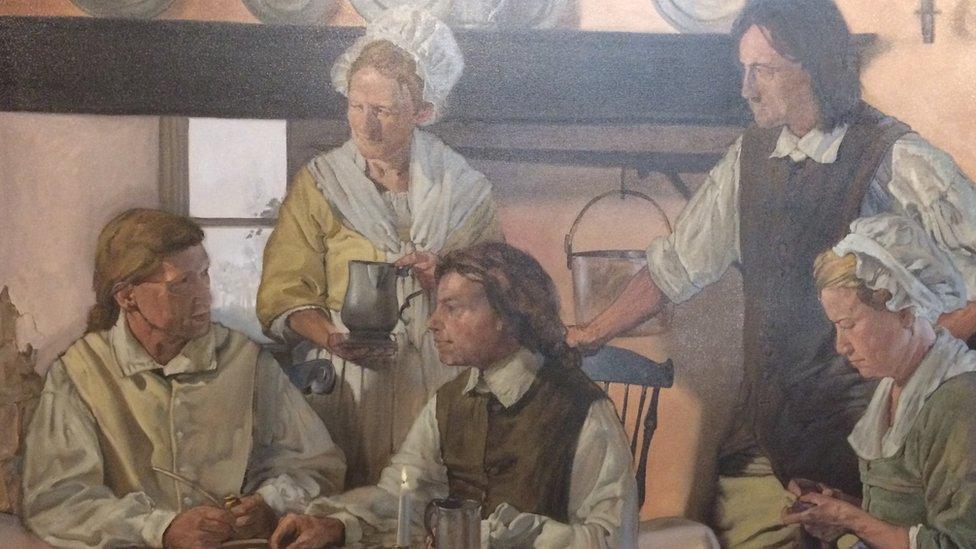
No portraits of either man remain, but US artist Adrian Martinez produced this interpretation of how Mason, seated left, and Dixon, also seated, might have looked during the project
Outdated maps meant fresh measurements were needed, but colonial surveyors had proved inaccurate. So the families hired Mason and Dixon, who were known in England as master surveyors and astronomers.
The Mason-Dixon Line was drawn in two parts. An 83-mile (133.5km) north-south divide between Maryland and Delaware and the more recognised 233-mile (375km) west to east divide between Pennsylvania and Maryland, stretching from just south of Philadelphia to what is now West Virginia.
Mr Thaler said: "This was the most outstanding scientific and engineering achievement, not only of its day, but of the American Enlightenment, external.
"It was so advanced for its time. The brains were the best and the technology was the best."
Mason and Dixon brought with them some of the most advanced surveying equipment of the day, including tools by renowned instrument maker John Bird,, external who, like Dixon, hailed from County Durham.
Mason-Dixon Line accuracy hailed as 'extraordinary'
"The map they produced is one of the most important historical documents we have here in America. It's almost the equivalent of the Declaration of Independence," added Mr Thaler.
"The accuracy is so extraordinary that even today it continues to astound. It represents the first geodetic survey, external in the New World."
Miner's son Dixon from Cockfield, near Bishop Auckland, and Mason, from Oakridge Lynch, near Stroud in Gloucestershire, originally came together in 1761 to map the Transit of Venus - making it easier to calculate the Earth's distance from the Sun.
It would take them almost five years - lugging their equipment across hundreds of miles of wilderness - to complete the survey and cement their place in the timeline of the United States.
Yet despite their groundbreaking achievement, both ended up in unmarked graves thousands of miles apart and remain virtually unknown in their home country.
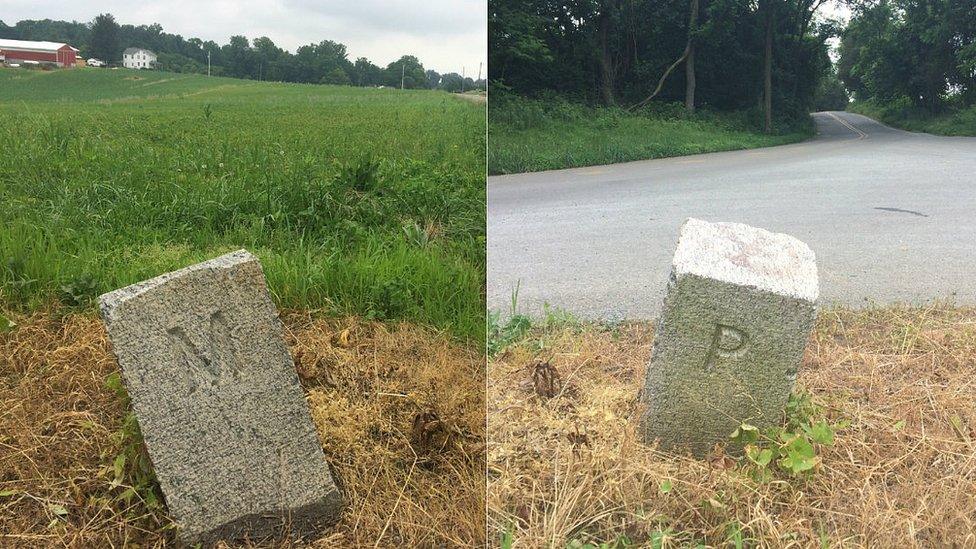
Milestones were marked with M for Maryland and P for Pennsylvania
Dixon's great-great-great-great-great-nephew, John Dixon, still lives in County Durham and is proud of his connection to a "marvellous man" who was of "great significance" in his lifetime.
"Jeremiah was a Quaker and from a mining family. He showed a talent early on for maths and then surveying.
"He went down to London to be taken on by the Royal Society, just at a time when his social life was getting a bit out of hand.
"He was a bit of a lad by all accounts, not your typical Quaker, and never married.
"He enjoyed socialising and carousing and was actually expelled from the Quakers for his drinking and keeping loose company."
Jeremiah Dixon relative reveals rift with Quakers
An entry in the Quaker minute book of Raby in County Durham, dated October 1760, reads: "Jery Dixon, son of George and Mary Dixon of Cockfield, disowned for drinking to excess."
Mr Dixon added: "Nevertheless, it's marvellous to be connected to such a prominent man."
Mason's early life was more sedate by comparison. At the age of 28 he was taken on by the Royal Observatory in Greenwich as an assistant. Noted as a "meticulous observer of nature and geography" he later became a fellow of the Royal Society.
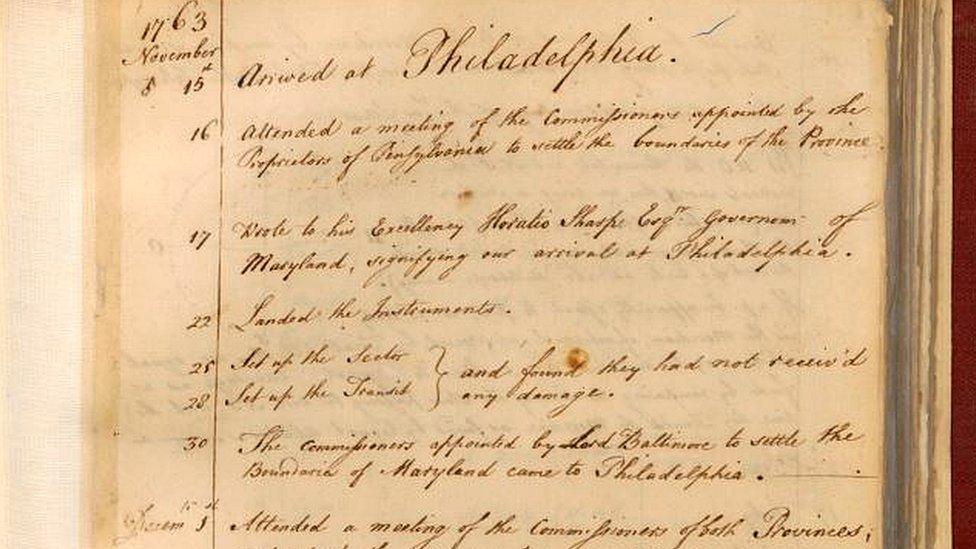
Mason chronicled his arrival in Philadelphia in his journal
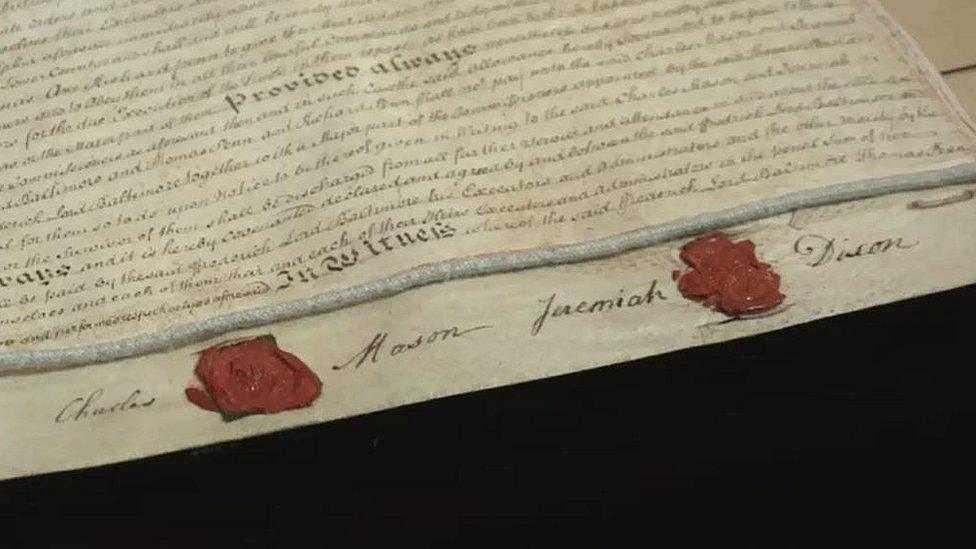
Mason and Dixon signed a contract to begin the survey in 1763
"Not too much is known about his younger days, but we know his family was not terribly well off and that they ran a baking business," said Royal Society librarian Keith Moore.
"He had a school education, but didn't go to university. However, he did have some local connections and knew James Bradley, external, who was a very famous astronomer and also from Gloucestershire.
"Bradley got him a job at the Royal Observatory, which is really the start of his career as an astronomer and surveyor.
"While at the Royal Society, he was asked to undertake Transit of Venus observations and recruited Dixon as his assistant."
Star observations were used to measure the Mason-Dixon Line
The pair arrived in Philadelphia to begin work in November 1763. They used Bird's instruments to calculate their path by the stars and had to combat hostile Native Americans, mountains, dense forest, rivers and wild animals.
Limestone markers measuring up to 5ft (1.5m) high - quarried and transported from England - were placed at every mile and marked with a P for Pennsylvania and M for Maryland on each side. So-called Crown stones were positioned every five miles and engraved with the Penn family's coat of arms on one side and the Calvert family's on the other.
"No-one really knows why the stones were shipped from England," said Todd Babcock, of the Mason and Dixon Line Preservation Partnership. "But we know there were nearly 400 of them."
He added: "At the time all Mason and Dixon had in front of them was wilderness.
"There were some settlements, but west of the Susquehanna River and approaching the Allegheny Mountains there were very few roads. It was all mature forest so they had to come through and cut a vista about 30ft wide.
"That required axe-men to cut down the trees, pack mule drivers to get the trees out of the way as well as cows for milk, chain carriers, instrument bearers and tent bearers. It was like a small army moving through the woods.
"They started off with a crew of five, but by the time they got towards the end of the survey the party had grown to about 115.
"When they came into this I think they thought it would take a year or two, but it ended up taking five."
Yet while their achievement has been rightly hailed, modern technology has shown the line was not as accurate as Mason and Dixon thought.

It took Mason and Dixon five years to complete their survey
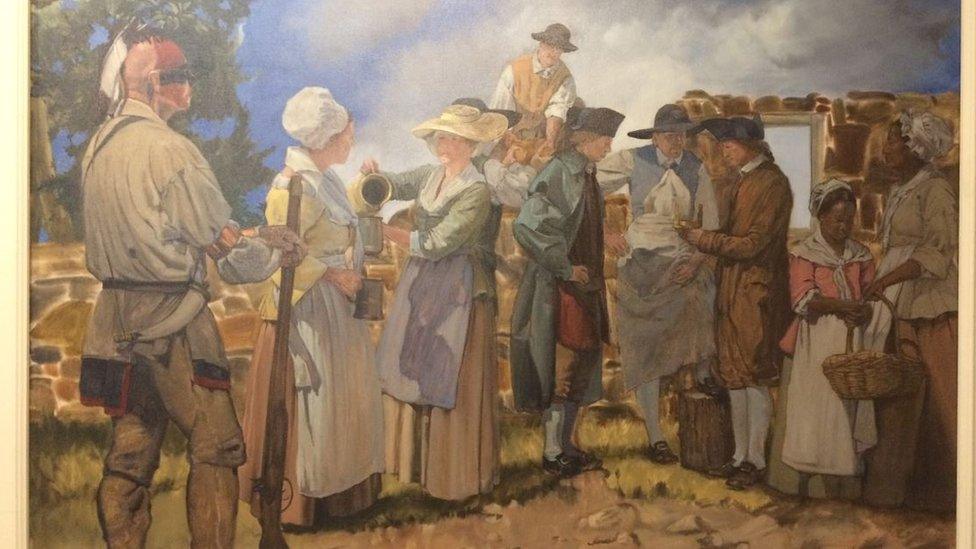
Adrian Martinex also imagined Mason and Dixon visiting a Pennsylvania tavern with some of their party a year into the survey

Crown stones were placed at five-mile intervals along the line
Mr Babcock said: "They thought at the end of the survey that the stones were accurate to within 50ft of where they should be. But what we're finding is that some of them are as much as 900ft off the intended line of latitude.
"Using modern GPS equipment we found they progressively went to the south and then started to come back to the north. The reason for that is not because they were inaccurate or because the equipment was faulty. It was actually gravity.
"Gravity had an impact on the plumb bob they were using. They had a 6ft telescope and it used a plumb bob on a fine wire to set it to true zero so they could measure directly overhead. But gravity varied from location to location because of the influence of things like mountains.
"We have found there was a direct correlation between the local variations in gravity and how far north or south of the line they were.
"The distances between the stones is supposed to be a mile, but what we're finding is that they are anything up to 15ft longer than a mile in places.
"That said, the idea of trying to stay on a line of latitude for 230 miles through the wilderness with equipment that had never been used before is just incredible."

Mason and Dixon
They were the subject of a 1997 novel by American author Thomas Pynchon
John Bird's fragile Zenith Sector, external, used for celestial measurements, had to be carried around by the surveyors' team on a mattress
Some historians suggest the word Dixie - a historical nickname for the South - derives from Jeremiah Dixon
Mark Knopfler's 2000 song Sailing to Philadelphia is about the surveyors
Mason has a moon crater named after him

Mason and Dixon began their return journey eastward on 20 October 1767 and later submitted a bill for £3,516.9s, external - estimated as the equivalent of about £500,000 today. But, according to David Thaler, neither died rich men.
"It was certainly a substantial amount for a world-class scientific effort," he said.
"But it wasn't enough to retire on."
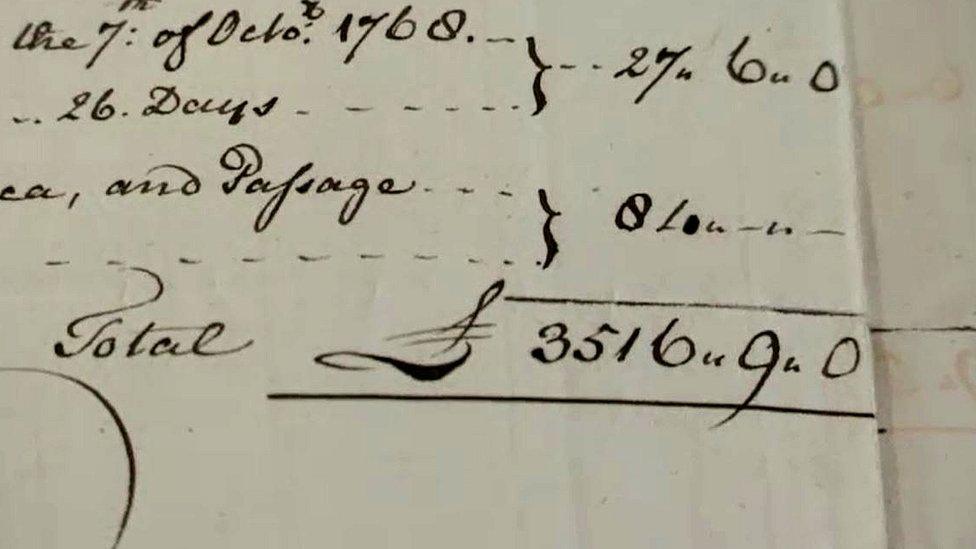
The bill for the Mason-Dixon Line came to just over £3,500
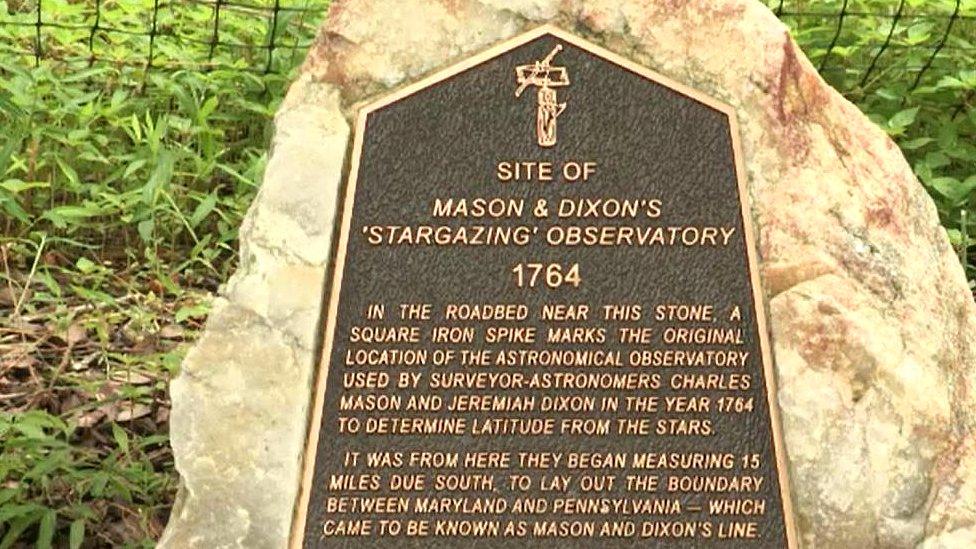
A plaque marks the spot close to where Mason and Dixon began their survey

The Mason-Dixon Line took on an enduring symbolism in part because of the American Civil War
Mason and Dixon are unlikely to have seen their names directly associated with their achievement, as the official report on the survey did not mention them.
The term "Mason-Dixon Line" would become more widely used when the Missouri Compromise, external was passed in 1820 to allow slave-owning Missouri and free Maine to join the union.
And of course the line's enduring symbolism was firmly established after the outbreak of the American Civil War in 1861, representing that demarcation between the North and South - and freedom over enslavement.
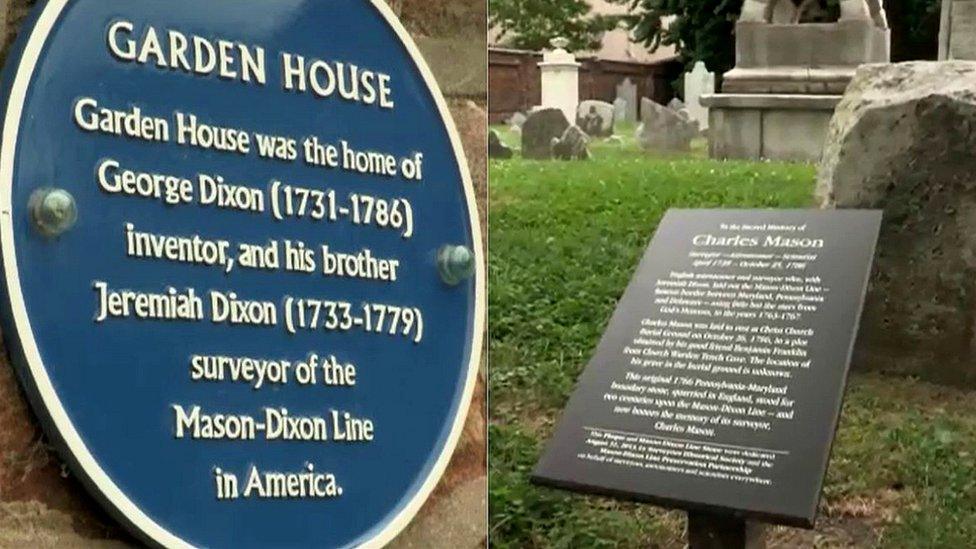
Mason and Dixon are buried thousands of miles apart in unmarked graves
After the mammoth project was completed, Mason returned to England to work again at the Greenwich Observatory but he ended his days virtually penniless back in America in 1786.
"Many years after the Mason-Dixon line was made, Mason returned to Philadelphia, but became sick during the journey," said John Hopkins, who oversees the burial ground at the city's Christ Church.
"When he got here he knew pretty much that he was close to death, so he wrote to Benjamin Franklin, who he knew, and asked him to give him a place to be buried so he didn't have to burden his wife and family.
"We don't know where he is. If he had a stone it's been lost over time.
"We have a plaque that a bunch of surveyors from around the country paid for with text close to what the inscription might have been at that time."

Charles Mason was friends with Benjamin Franklin, according to John Hopkins of Christ Church
Dixon returned to County Durham to ply his trade.
"For the last 10 years of his life he did work for Lord Barnard at Raby Castle and surveyed Auckland Castle for the Bishop of Durham," his relative John Dixon said:
"He died at the young age of 45 in 1779. There was no death certificate. We know he'd been quite a steady drinker through his life and there were rumours he died from pneumonia.
"We presume that after having been put out of the Quakers they reconciled and accepted him back. He is buried in the Quaker burial ground at Staindrop.
"We don't know exactly where he is because it was the convention at that time for Quakers not mark their gravestones."
Find out about musician Mark Knopfler's fascination with Mason and Dixon on Inside Out on BBC1 at 1930 BST on 4 September.
- Published12 September 2013
.jpg)
- Published4 May 2013
